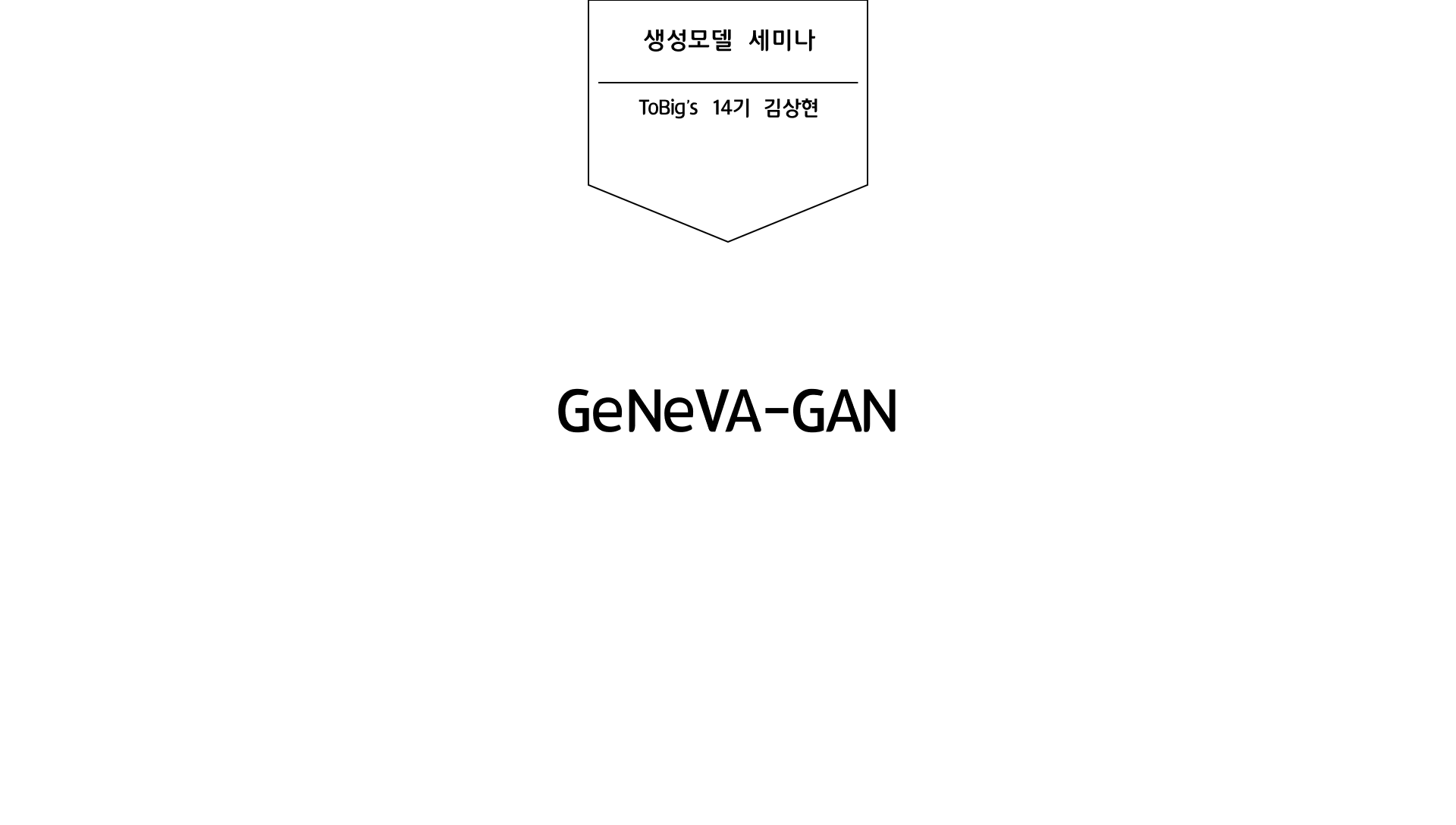
작성자 : 시립대학교 수학과 김상현
Tell,Draw,and Repeat: Generating and Modifying Images Based on Continual Linguistic Instruction
Introduction
paper : Tell, Draw, and Repeat: Generating and Modifying Images Based on Continual Linguistic Instruction(2019 ICCV)
GeNeVA는 Generative Neural Visual Artist로 빈 캔버스에 점진적으로 그림을 그리는 과정에 영감을 받았다. 주어진 caption(사진 삽화에 붙은 설명)에 따라 이미지를 만드는 것이 아닌 continual linguistic 입력을 기반으로 반복적으로 이미지를 생성한다.
Task and Datasets
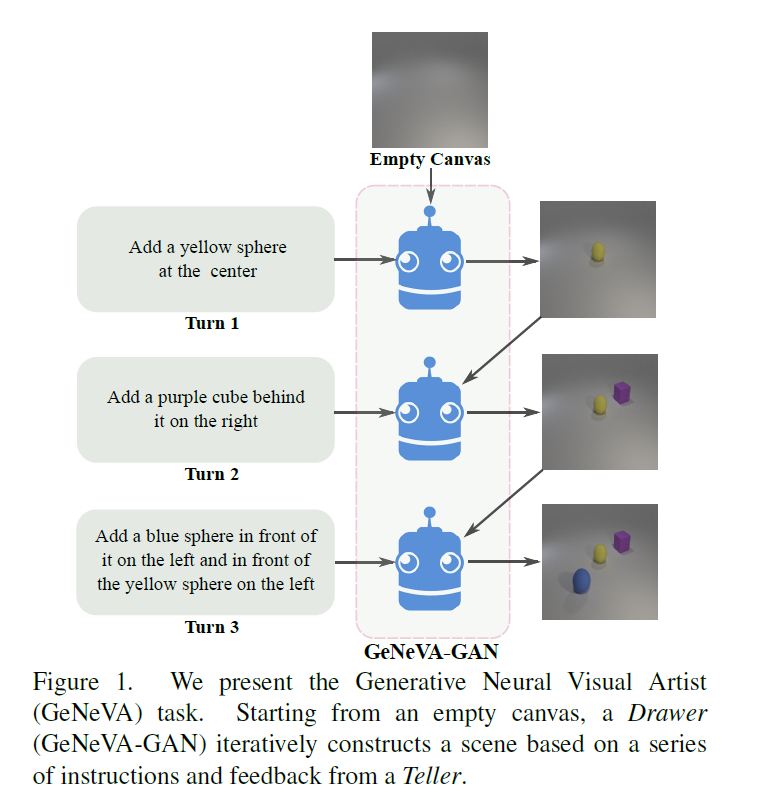
GeNeVA는 Teller와 Drawer가 존재한다. Teller는 지시를 하고, Drawer는 지시에 맞게 캔버스에 그림을 반복적으로 그려나간다. Teller는 Drawer가 생성한 이미지를 통해 전체 과정의 진전을 판단하다. Drawer는 지시에 맞는 물체를 물체의 특성을 잘 살리면서 또한 물체들간의 위치를 고려하여 이미지를 생성해야 한다. Drawer는 또한 이전의 이미지와 지시를 유지하는 방식으로 이미지를 수정해 나가야한다. 따라서 이전의 이미지와 지시를 기억하고 있어야 한다.
사용한 데이터셋은 CoDraw dataset과 CLEVR dataset을 iterative하게 변형시킨 i-CLEVR dataset을 이용했다.
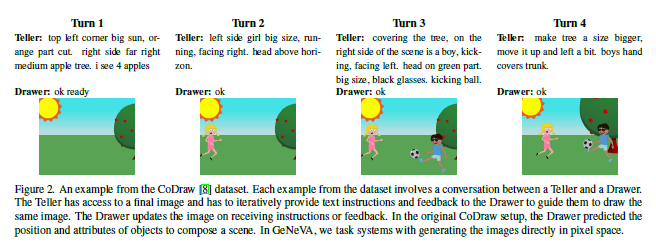

CoDraw dataset과 i-CLEVR dataset 예시
두 dataset 모두 합성 이미지(실제 사진과 같은 이미지가 아닌)들로 구성된 dataset이다. 해당 논문의 저자들은 "합성 이미지를 통해 모델의 성능을 향상시킬 수 있었고, 사실적인 이미지(사진)는 더욱 도전적인 작업이지만, 이 모델은 합성 이미지를 생성하는데만 국한되지 않는다"고 밝혔다.
Contributions
- Instruction history의 맥락에서 이미지의 그럴듯한 수정에 특화된 새로운 recurrenct GAN을 제안한다.
- i-CLEVR dataset을 소개한다.
- 지시에 합당한 위치에 물체들을 위치시키는 능력을 평가하기 위해 rsim(relationship similarity) metric을 제안한다.
- 비반복적 생성 모델과 비교하며 반복적 생성 모델의 중요성을 설명한다.
Model
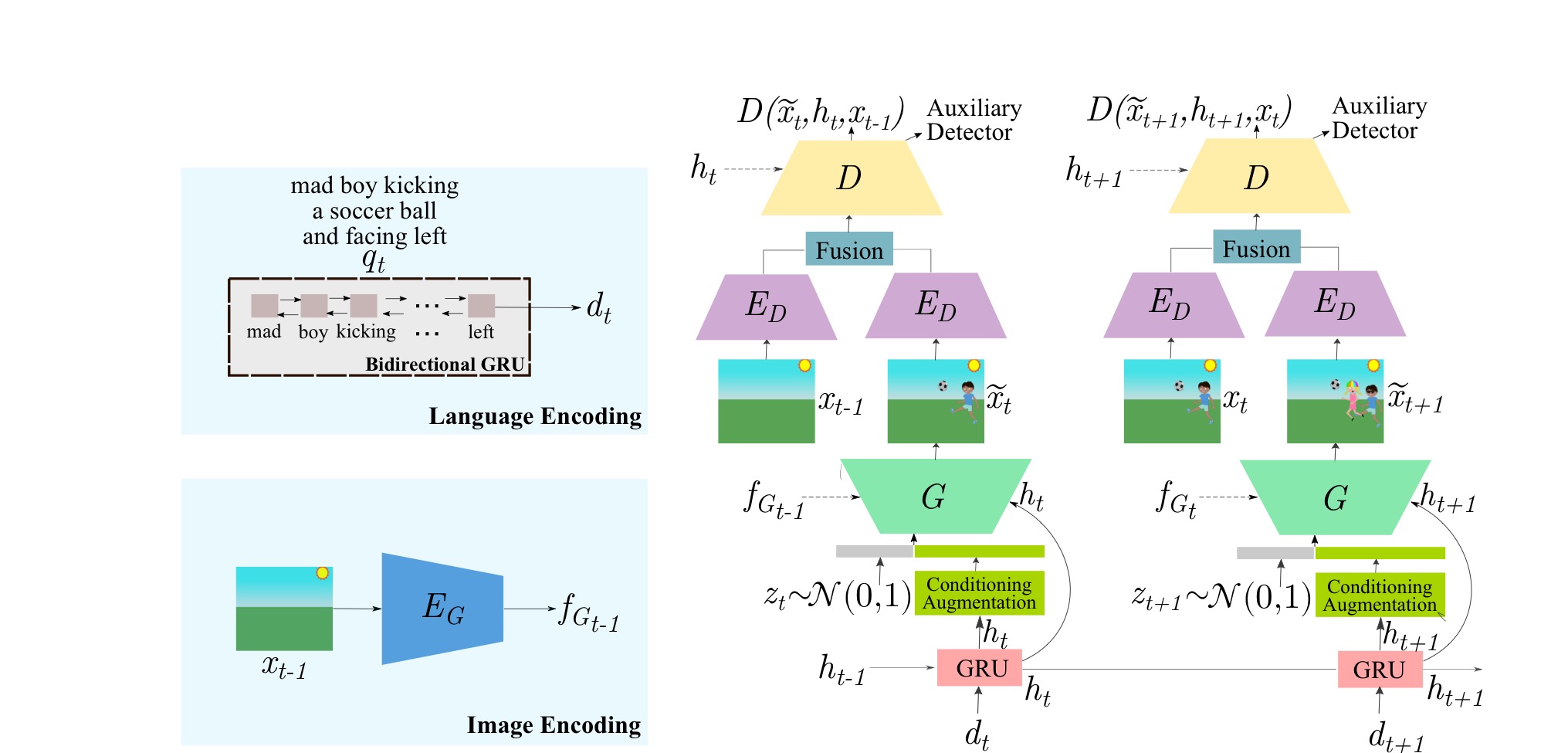
notation
: canvas
Q = (,...,): sequence of instructions
G/D: generator/discriminator
R: second GRU
: image encoder(shallow CNN)
: image encoder for discriminator
: a noise vector sampled from N(0,1)
: context-aware condition
: context-free condition
: ground-truth image
: generated image
Generator part
t 시점의 합성된 이미지 = G(, , )
먼저 generator의 각 입력들에 대해 알아보자.
- 는 위의 notation과 마찬가지로 t 시점의 noise vector이다.
- 는 context-aware condition으로 = R(, ) 이다. 먼저 는 t 시점의 instruction 를 bi-directional GRU GloVe word embedding을 이용해 인코딩 된 벡터이다. 따라서 는 instruction encoding 와 t-1시점의 context-aware condition 을 입력으로 받아 R(GRU)를 통과하여 현 시점의 정보(insturction)와 이전 시점의 정보(instruction)를 종합하여 새로운 이미지를 그리는데 수정해야할 부분을 나나태는 벡터이다.
- 은 context-free condition으로 = ()이다. 이전 시점에 생성된 이미지를 인코딩하여 현재 캔버스의 정보를 나타내는 벡터이다.
다음으로 t 시점의 합성된 이미지 가 합성되는 과정을 확인하자.
1. t 시점의 instruction 를 language encoder를 통해 를 생성
2. R(, )을 통해 생성
3. 와 conditioning augmentation을 통한 를 concat하여 noise vector 생성
4. t-1 시점의 이미지를 image encoder를 통해 를 생성
Conditioning Augmentation(CA)
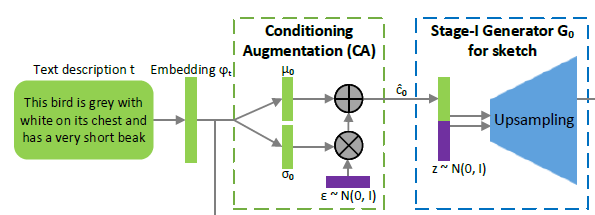
이미지 출처:Stack-GAN
기존에는 text condition을 나타내는 를 을 비선형 변환하여 생성했다. 하지만 이런 경우 고정된 는 의 높은 차원(100-dimensions 이상)의 latent space를 잘 표현하지 못하고, 데이터의 양이 적을 경우 latent data manifold에 불연속성을 야기한다. 이러한 문제들은 generator 학습에서 바람직하지 못하다.
해당 문제들을 해결하기 위해 Stack-GAN에서 CA를 사용한다. CA는 위의 그림과 같이 = mean (), = diagonal covariance matrix ()를 이용해 을 (, )에서 랜덤 샘플링을 통해 생성한다. 랜덤 샘플링을 위해 표준정규분포에서 랜덤 샘플링한 을 이용해 = + 을 구한다.
CA를 통해 coditioning manifold의 작은 변화(perturbation)에 대한 robustness를 증가시킬 수 있다. 또한 CA의 randomness를 통해 text to image translation에서 동일한 text에 대해 다양한 포즈와 형태를 갖는 이미지를 얻을 수 있다.
추가로 conditioning manifold의 smoothness를 강화하고, overfitting을 막기 위해 KL divergence regularization: 을 사용한다. 해당 regularization은 generator loss에 추가해서 regularize를 수행한다.
[Code]
# https://github.com/Maluuba/GeNeVA/blob/master/geneva/definitions/conditioning_augmentor.py
class ConditioningAugmentor(nn.Module):
def __init__(self, emb_dim, ca_dim):
super(ConditioningAugmentor, self).__init__()
self.t_dim = emb_dim
self.c_dim = ca_dim
self.fc = nn.Linear(self.t_dim, self.c_dim * 2, bias=True)
self.relu = nn.ReLU()
def encode(self, text_embedding):
x = self.relu(self.fc(text_embedding))
mu = x[:, :self.c_dim]
logvar = x[:, self.c_dim:]
return mu, logvar
def reparametrize(self, mu, logvar):
std = logvar.mul(0.5).exp_()
eps = torch.cuda.FloatTensor(std.size()).normal_()
return eps.mul(std).add_(mu)
def forward(self, text_embedding):
mu, logvar = self.encode(text_embedding)
c_code = self.reparametrize(mu, logvar)
return c_code, mu, logvarConditional Batch Normalize(CBN)
GeNeVA-GAN의 generator의 모든 convolution layer에 CBN을 적용했다.
CBN은 condition에 따라 Batch Normalize(BN)을 적용하는 방법이다.
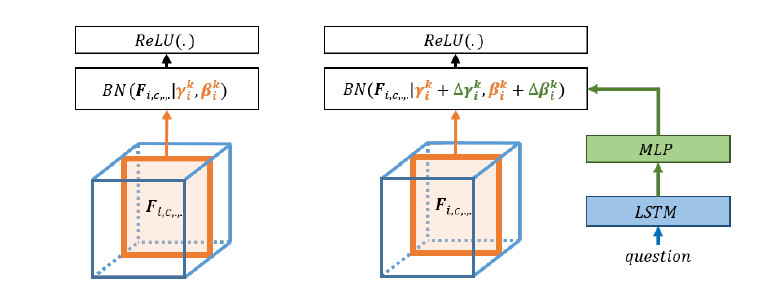 이미지 출처: Modulating early visual processing by language 논문
이미지 출처: Modulating early visual processing by language 논문
기존의 BN에 경우 text embedding 정보를 담고 있는 , 를 학습하기 여렵다. CBN은 text embedding을 MLP를 통과시킨 값을 기존의 BN에 추가하여 수행한다.
기존의 BN: BN(|, )

CBN: BN(|, ), = +, = +
, : pre-trained된 값 또는 임의의 초기값
, : MLP(), = text embedding
CBN의 장점: 컴퓨터 연산적 효율성이 늘어나고, text embedding으로 feature maps를 조작할 수 있게 된다.
[code]
# https://github.com/Maluuba/GeNeVA/blob/master/geneva/definitions/conditional_batchnorm.py
class ConditionalBatchNorm2d(nn.Module):
def __init__(self, in_channels, conditon_dim):
super().__init__()
self.channels = in_channels
self.bn = nn.BatchNorm2d(in_channels, affine=False)
self.fc = nn.Linear(conditon_dim,
in_channels * 2)
self.fc.weight.data[:, :in_channels] = 1
self.fc.weight.data[:, in_channels:] = 0
def forward(self, activations, condition):
condition = self.fc(condition)
gamma = condition[:, :self.channels]\
.unsqueeze(2).unsqueeze(3)
beta = condition[:, self.channels:]\
.unsqueeze(2).unsqueeze(3)
activations = self.bn(activations)
return activations.mul(gamma).add(beta)Discriminator part

GeNeVA-GAN은 이미지를 반복적으로 수정하면서 이미지를 생성하므로 각각의 시점에서 이미지의 real/fake 판별로는 충분한 학습이 이루어질 수 없다. 따라서 논문의 저자들은 기존의 discriminator들과 다르게 3가지 변화를 줬다.
- image encoder 를 이용해 t-1 시점의 ground-truth 이미지 과 t시점에 생성된 이미지 를 인코딩 한 후 두 인코딩된 벡터를 fusion layer를 통과시킨다. fusion layer는 학습을 하는 layer가 아닌 인코딩 된 feature map들의 element-wise subtraction 또는 concatation을 수행한다. fusion layer를 이용하는 방법으로 discriminator는 이미지의 변화에 더 집중할 수 있다. 추가로 projection discriminator을 사용했다.
- discrminator loss에 real/fake loss외에 (real image, wrong instruction)쌍을 통해 계산되는 wrong loss를 추가했다.
- 해당 시점에 존재하는 객체(objects)들의 존재를 알기 위한 auxiliary objective를 사용했다.
Projection Discriminator
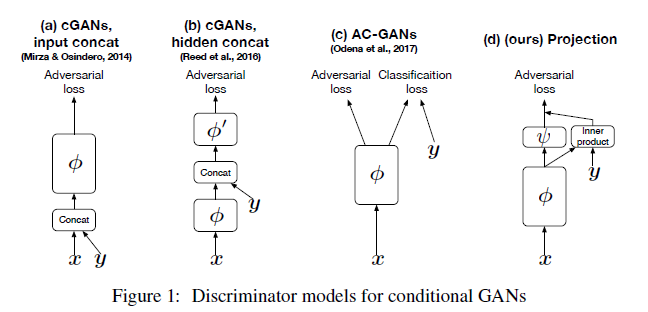 이미지 출처: cGANs with Projection Discriminator 논문
이미지 출처: cGANs with Projection Discriminator 논문
V: y(condition)에 대한 embedding vector
: 기존의 CNN layers discriminator
: scalar function
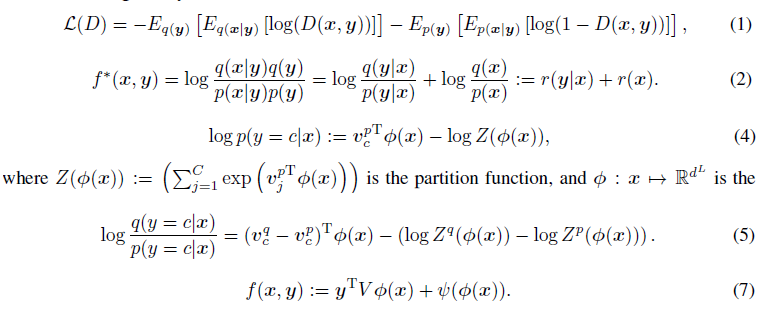 이미지 출처: cGANs with Projection Discriminator 논문
이미지 출처: cGANs with Projection Discriminator 논문
p : generated distribution
q : true distribution
r : log likelihood ratio
식(1)의 = , A = activation function(주로 sigmoid)
식(2)는 기존의 loss function인 식(1)의 optimal solution 을 두 개의 log likelihood ratio의 합으로 나타낸것이다.
log linear model 식(4)를 이용해서 식(2)의 를 나타낸것이 식(5)이다. 같은 방법으로 식(2)의 또한 나타낼 수 있다.
이것들을 정리하면 식(7) 를 정의할 수 있고, 이 식은 위의 식 와 같다.
위와 같이 정의된 를 이용한 discriminator를 사용하는 경우 기존의 condtional GAN들 보다 성능이 좋았다
[code]
https://github.com/Maluuba/GeNeVA/blob/master/geneva/models/networks/discriminator_factory.py (코드가 길어서 링크만 첨부)
위 주소의 코드 144~146줄을 보면 projection discriminator의 구현을 확인할 수 있다.
Loss
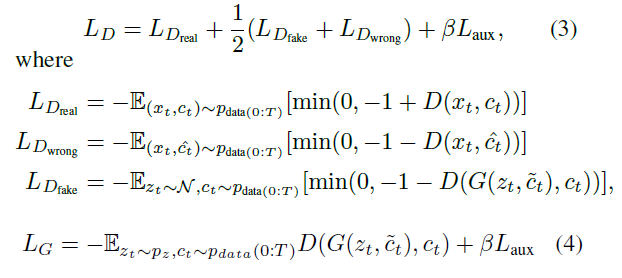
: {, }
: t시점의 이미지 와 맞지 않는 instruction
: {, }
Hinge Advesarial Loss를 사용했다.
Hinge Adversarial Loss
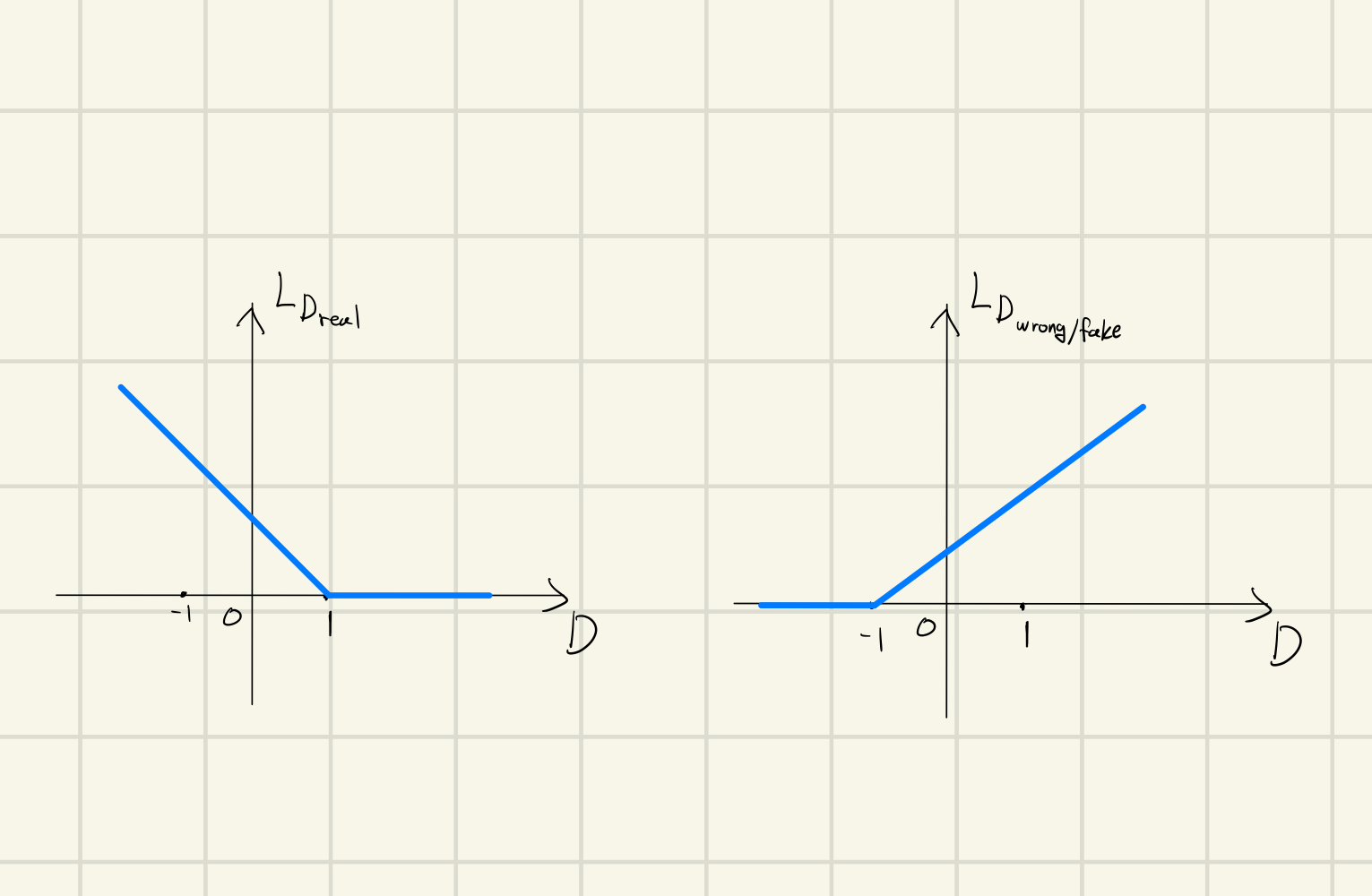
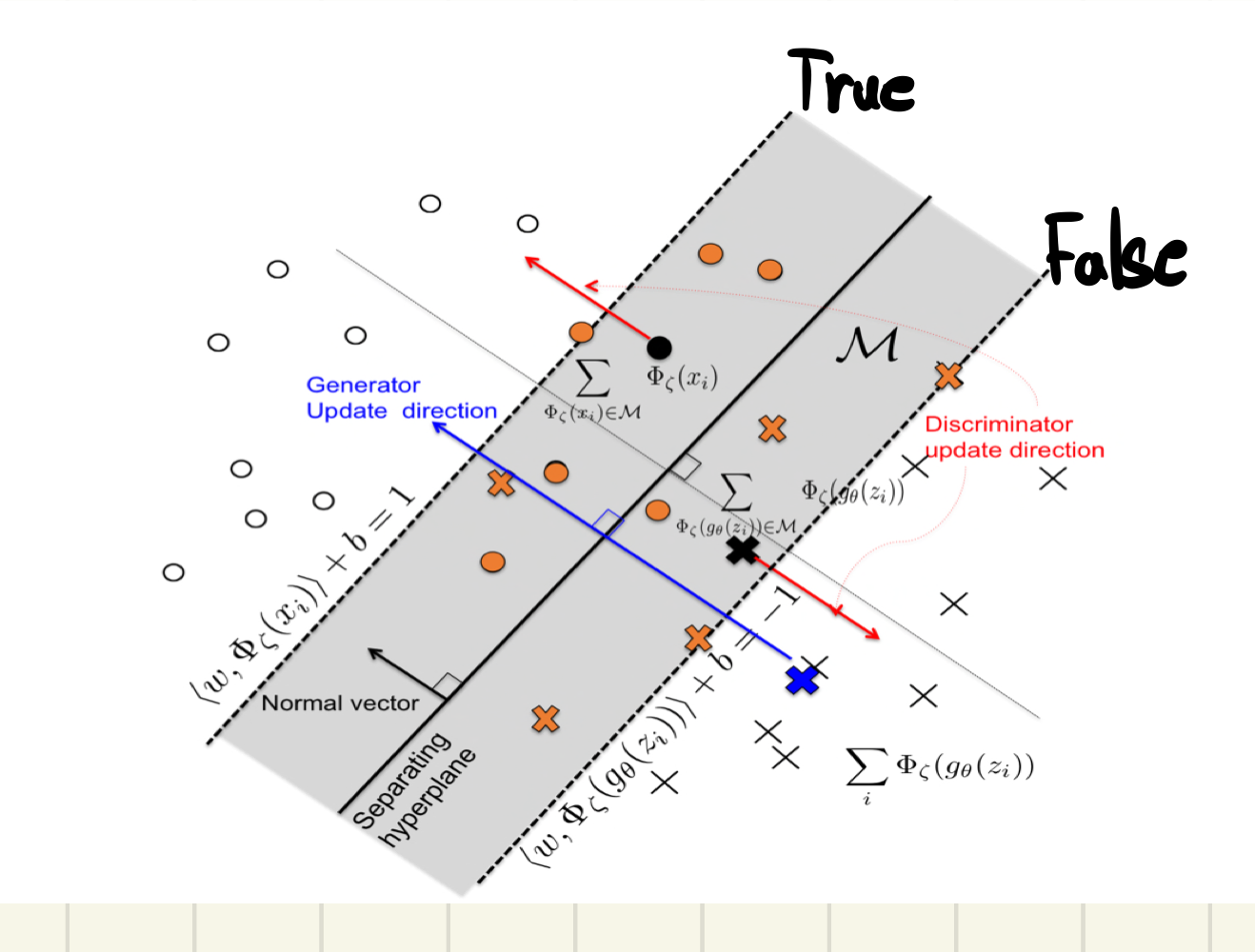
이미지 출처: Geometric-GAN
Discriminator의 마지막 활성화 함수는 identity function으로 sigmoid를 사용하지 않는다. real pair (, )에 대해 discriminator 출력값이 1 이하인 경우에만 학습하고, fake/wrong pair에 대해 discriminator 출력값이 -1이상인 경우에만 학습을 한다.
hinge loss를 사용하면 기존의 gan loss보다 mode collapse 문제를 해결할 수 있다는 장점이 있다.
[code]
# https://github.com/Maluuba/GeNeVA/blob/master/geneva/criticism/losses.py
class HingeAdversarial():
@staticmethod
def discriminator(real, fake, wrong=None, wrong_weight=0.):
l_real = F.relu(1. - real).mean()
l_fake = F.relu(1. + fake).mean()
if wrong is None:
return l_real + l_fake
else:
l_wrong = F.relu(1. + wrong).mean()
return l_real + wrong_weight * l_wrong + (1. - wrong_weight) * l_fakeAuxiliary Loss

t 시점 N개(dataset에 존재하는 모든 개체의 수)의 개체 각각에 대한 BCEloss를 계산한다. 뒤에 설명할 projection conditioning 이전의 discriminator layer에 N차원 linear layer를 추가하고, 활성화 함수로 sigmoid를 사용하여 각각의 를 얻는다.
Zero-centered Gradient Panalty

학습의 안정성을 위해 discriminator의 parameters 를 regularize 시킨다. gradient가 커지는 것을 막아준다. (:hyper parameter)
Implementation Details
model의 구조와 관련된 2가지
- self-attention layer
- spectral normalization
Self-Attention Layer
GeNeVA-GAN의 generator/discriminator의 layers 중간에 들어간다.
Self-Attention GAN(SAGAN)은 기존의 convolutional 연산만을 이용한 GAN은 CNN의 local receptive field로 인하여 Long-range dependence를 잘 고려하지 못하는 문제를 해결하기 위해 self-attention을 적용했다.
참고) Long-range dependence(LRD): is a phenomenon that may arise in the analysis of spatial or time series data. It relates to the rate of decay of statistical dependence of two points with increasing time interval or spatial dsitance between the points => 시간 간격/공간 거리가 증가함에 따라 두점의 통계적 의존성 붕괴율과 관련됨
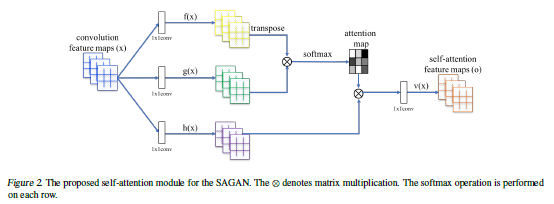 이미지 출처: SA-GAN 논문
이미지 출처: SA-GAN 논문
[code]
# https://github.com/Maluuba/GeNeVA/blob/master/geneva/definitions/self_attention.py
class SelfAttention(nn.Module):
def __init__(self, C):
super(SelfAttention, self).__init__()
self.f_x = spectral_norm(
nn.Conv2d(in_channels=C, out_channels=C // 8, kernel_size=1))
self.g_x = spectral_norm(
nn.Conv2d(in_channels=C, out_channels=C // 8, kernel_size=1))
self.h_x = spectral_norm(
nn.Conv2d(in_channels=C, out_channels=C, kernel_size=1))
self.gamma = nn.Parameter(torch.zeros(1))
def forward(self, x):
B, C, H, W = x.size()
N = H * W
f = self.f_x(x).view(B, C // 8, N)
g = self.g_x(x).view(B, C // 8, N)
s = torch.bmm(f.permute(0, 2, 1), g) # f(x)^{T} * g(x)
beta = F.softmax(s, dim=1)
h = self.h_x(x).view(B, C, N)
o = torch.bmm(h, beta).view(B, C, H, W)
y = self.gamma * o + x
return ySpectoral Normalization(SN)
GeNeVA-GAN의 discriminator의 모든 layer에 SN을 사용했다. SN은 다른 normalize와 같이 pytorch에 구현되있다.
 이미지 출처: SN-GAN
이미지 출처: SN-GAN
= , A: activation function
가 유계가 아니거나 심지어 계산이 불가능할 수 있다. 이러한 문제를 해결하기 위해 즉 K-Lipschitz 제약을 준다.
은 norm을 이용해 정해진 구간에서 임의의 ,에 대해 M을 의미한다. 여기서 M은 립시츠 상수
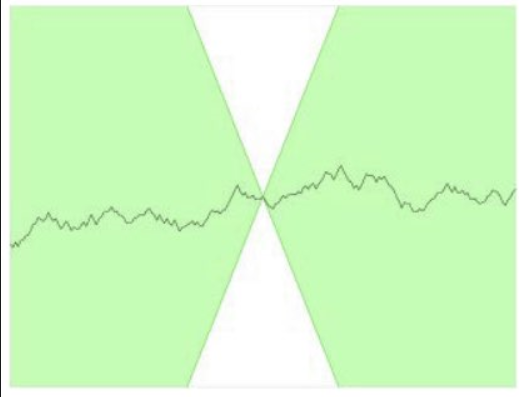 이미지 출처 : https://velog.io/@tobigs-gm1/basicofgan
이미지 출처 : https://velog.io/@tobigs-gm1/basicofgan
이와 같은 립시츠 제약은 WGAN에서 사용되었다. WGAN은 1-립시츠 제약을 위해 weight clipping을 사용했었다.
 이미지 출처: SN-GAN
이미지 출처: SN-GAN
: spectral norm( matrix norm)
: 의 eigen value 중 가장 큰 값을 일 때,
식(7)을 보면 의 립시츠 상수는 각 layer의 W들의 spectral norm의 곱들보다 작다. 따라서 각 layer의 W를 (W)로 normalize 하면 즉 W = 이면 립시츠 상수가 1이 된다.
SN은 각 layer의 transformation이 한 방향으로 민감(sensitive)해지는 것을 방지한다. 이러한 원리로 SN-GAN은 WGAN, WGAN-GP, Batch Norm, Layer Norm 등의 다른 방법들 보다 좋은 성능을 보였다.
Evaluation
성능 평가를 위해 Inception-v3 구조를 기반으로 한 object detector와 localizer를 만들었다. Inception-v3의 마지막 layer를 linear layer with sigmoid와 linear layer 두 부분으로 수정하여 첫 번째 부분은 object detect를 위한 분류기로 사용하고, 두 번째 부분은 localizer를 위해 개체의 좌표를 회귀한다.
GeNeVA-GAN의 성능평가는 기존의 GAN의 성능평가를 위한 Inception score와 FID가 부적절하여 object detecotor와 localizer를 이용해 precision,recall,F1-score를 구한다. 또한 object detector와localizer를 이용해 노드가 개체이고, 엣지가 위치관계(앞,뒤,좌,우)인 그래프를 생성한다. real/fake 이미지의 그래프를 비교해 개체들이 올바른 위치에 존재하는지 평가할 수 있다. 이 평가를 위해 Relational Similarity를 구한다.
Relational Similarity
관계 유사성으로 개체가 올바른 위치에 있는지 평가한다.
real/fake 이미지가 같은 개체들을 갖고 있는 경우 중 위치가 일치하는 비율에 recall을 곱해서 Relational Similarity를 구할 수 있다.
[code]
# https://github.com/Maluuba/GeNeVA/blob/master/geneva/metrics/inception_localizer.py
def get_graph_similarity(detections, label, locations, gt_locations, dataset):
intersection = (detections & label).astype(bool)
if not np.any(intersection):
return 0
locations = locations.data.cpu().numpy()[intersection]
gt_locations = gt_locations.data.cpu().numpy()[intersection]
genereated_graph = construct_graph(locations, dataset)
gt_graph = construct_graph(gt_locations, dataset)
matches = (genereated_graph == gt_graph).astype(int).flatten()
matches_accuracy = matches.sum() / len(matches)
recall = recall_score(label, detections, average='samples')
graph_similarity = recall * matches_accuracy
return graph_similarityConclusion
GeNeVA-GAN을 통해 주어진 instructions에 따라 반복적으로 합리적인 그림을 그릴 수 있는 것을 확인했다. 실험을 통해 비반복적 방법도 어느 정도 성능을 보일 수 있으나 반복적인 방법에 비해 낮은 성능을 확인했다. 또한 해당 모델을 위한 새로운 metric(Relational Similarity)을 제안했다.
마지막으로 실제 사진과 같은 이미지로 학습하기 위해 해당 모델에 맞는 주석이 달려있는 image sequence가 필요하다.
References
Geometric-GAN: Jae Hyun Lim and Jong Chul Ye, “Geometric GAN,”
arXiv:1705.02894 [stat.ML], 2017.
SN-GAN: Takeru Miyato, Toshiki Kataoka, Masanori Koyama,
and Yuichi Yoshida, “Spectral normalization for generative
adversarial networks,” in International Conference
on Learning Representations (ICLR), 2018.
SA-GAN: Han Zhang, Ian Goodfellow, Dimitris Metaxas, and
Augustus Odena, “Self-attention generative adversarial
networks,” arXiv:1805.08318 [stat.ML], 2018.
projection discriminator: Takeru Miyato and Masanori Koyama, “cGANs with
projection discriminator,” in International Conference
on Learning Representations (ICLR), 2018.
zero-gentered gradient penalty: Lars Mescheder, Andreas Geiger, and Sebastian
Nowozin, “Which training methods for GANs do actually
converge?” in International Conference on Machine
learning (ICML), 2018.
conditional batch normalization: Harm de Vries, Florian Strub, J´er´emie Mary, Hugo Larochelle, Olivier Pietquin, and Aaron C Courville. Modulating
early visual processing by language. In NIPS, pp. 6576–6586, 2017.
Stack-GAN: Han Zhang, Tao Xu, Hongsheng Li, Shaoting Zhang,
Xiaogang Wang, Xiaolei Huang, and Dimitris N.
Metaxas, “StackGAN: Text to photo-realistic image
synthesis with stacked generative adversarial networks,”
in International Conference on Computer Vision
(ICCV), 2017.
출처가 없는 이미지: GeNeVA-GAN 논문 내의 이미지
8개의 댓글
투빅스 14기 김민경
- GeNeVA는 빈 캔버스에 점진적으로 그림을 그리는 과정에 영감을 받았다.
- continual linguistic 입력을 기반으로 반복적으로 이미지를 생성한다. (이미지의 그럴듯한 수정에 특화된 새로운 recurrenct GAN을 제안)
- Teller와 Drawer가 존재하는데, Teller는 지시하고 Drawer는 지시에 맞게 캔버스에 그림을 반복적으로 그려나간다.
- 지시에 합당한 위치에 물체들을 위치시키는 능력을 평가하기 위해 rsim metric 제안했다.
- : text condition는 를 비선형 변환하여 생성했지만, 이 경우에는 높은 차원 latent space를 잘 표현하지 못하고, 데이터의 양이 적을 경우 latent data manifold에 불연속성을 야기한다는 한계가 있다. -> 해결 위해 Stack-GAN에서 CA(Conditioning Augmentation)를 사용
- CA를 통해 coditioning manifold의 작은 변화(perturbation)에 대한 robustness를 증가시킬 수 있으며 andomness를 통해 text to image translation에서 동일한 text에 대해 다양한 포즈와 형태를 갖는 이미지를 얻을 수 있다.
- 또한, generator의 모든 convolution layer에 condition에 따라 Batch Normalize(BN)을 적용하는 방법인 CBN을 적용했다. CBN은 text embedding을 MLP를 통과시킨 값을 기존의 BN에 추가하여 수행한다.
- : GeNeVA-GAN은 이미지를 반복적으로 수정하면서 이미지를 생성하므로 각각의 시점에서 이미지의 real/fake 판별로는 충분한 학습이 이루어질 수 없기 때문에 기존과 비교해 3가지 변화를 주었다. 1. fusion layer를 이용하는 방법 2. (real image, wrong instruction)쌍을 통해 계산되는 wrong loss 추가 3. auxiliary objective 사용
- Hinge Advesarial Loss를 사용해서 기존의 GAN loss 대비 mode collapse 문제에서 성능이 좋다.
- discriminator의 모든 layer에 SN을 사용했다. SN은 각 layer의 transformation이 한 방향으로 민감해지는 것을 방지한다.
- 기존 GAN의 성능평가를 위한 Inception score, FID가 부적절하여 GeNeVA의 성능 평가를 위해 object detector, localizer를 제시했다.
- 어려운 내용을 꼼꼼히, 잘 설명해주셔서 흥미롭고 유익한 강의였습니다. 감사합니다:)
투빅스 11기 이도연
GeNeVA-GAN, 너무 새롭고 신기한 논문이라서 이런 논문을 다뤄주셔서 감사합니다!
- GeNeVA-GAN은 continual linguistic 입력을 기반으로 반복적으로 이미지를 생성한다. Teller와 Drawer가 존재하고, Teller는 지시를, Drawer는 지시에 맞게 캔버스에 그림을 반복적으로 그려나간다. 그리고 Teller는 Drawer가 생성한 이미지를 통해 전체 과정의 진전을 판단하고, Drawer는 지시에 맞는 물체의 특성과 위치를 고려해 이미지를 생성해야 한다.
- Generator part에서의 input을 살펴보면 t시점의 noise vector와 현 시점의 정보와 이전 시점의 정보를 종합하여 수정해야 할 부분을 나타내는 벡터, 이전 시점에 생성된 이미지를 인코딩하여 현재 캔버스의 정보를 나타내는 벡터가 있다. 이 때 noise vector를 생성 할 때 conditioning augmentation을 이용했고 generator의 모든 conv layer에 Conditional Batch Normalize(CBN)을 적용했다.
- Discriminator part에서는 fusion layer를 이용해 이미지의 변화에 더 집중하도록 하고, projection discriminator를 사용했다. 그리고 hinge adversarial loss를 사용했다. Discriminator의 모든 layer에서 Spectoral Normalixation(SN)을 사용했다.
- Relational Similarity로 개체가 올바른 위치에 있는지를 평가하는 지표가 있다. 이 모델의 학습을 위해서는 주석이 달려있는 image sequence가 필요하다.
투빅스 14기 박준영
이번 강의는 GeNeVa-Gan에 관한 내용으로 투빅스 14기 김상현님께서 진행해주셨습니다.
-
GeNeVa는 Generative Neural Visual Artist의 약자로 caption에 따라 이미지를 만드는 것이 아닌 continual linguistic 입력을 기반으로 반복적으로 이미지를 생성한다.
-
GeNeVa는 Teller와 Drawer가 존재하는데 Teller는 지시를 하고 Drawer는 그림을 그려나간다.
-
Generatator part에서는 t 시점의 sequence of instruction를 language encoder를 통하여 inconstruction encoding dt를 생성하고
-
d_t와 t-1 시점의 context-aware condition을 입력으로 받아 현시점의 context-aware condition 생성
-
z_t 와 conditioning augmentation을 통한 h_t를 concat하여 noise vector 생성
-
이때 conditioning augmentation는 text condition을 비선형 변환할때 높은차원의 latent space를 표현하지 못하고 데이터양이 적을때 latent data manifold에 불연속성을 야기하끼 때문에 CA를 통해 coditioning manifold의 작은 변화(perturbation)에 대한 robustness를 증가시키고 CA의 randomness를 통해 text에 다양한 형태를 얻는다.
-
t-1시점의 이미지를 image encoder를 통해 contest-free condition f(g_t_1)생성
-
Generator의 모든 convolution layer에 text embedding을 MLP에 통과시킨 값을 Batch Normalization에 추가한 Conditional Batch Normalize(CBN)를 적용. 이로써 컴퓨터 연산 효율성 늘고 text embedding으로 feature maps 조작
-
Discriminator part에서는 image encoder E_D를 이용해 t-1 시점의 ground-truth 이미지와 t시점에 생성된 이미지를 인코딩해서 두 벡터를 fusion layer를 통과시킨다. 이를 통해 discriminator는 이미지 변화에 집중한다.
-
Discriminator loss에 real/fake loss외에 (real image, wrong instruction)쌍을 통해 계산되는 wrong loss를 추가
-
각 에 존재하는 객체(objects)들의 존재를 알기 위한 auxiliary objective를 사용했다.
-
GeNeVA-GAN을 통해 주어진 caption에 따라 반복적으로 합리적인 그림을 그릴 수 있는것을 확인
구연동화하듯이 teller의 지시에 따라 image가 생성된다는 것이 신기했고 구조가 복잡함에도 구조를 한눈에 볼 수 있었습니다. 좋은 강의 감사합니다!
투빅스 13기 이예지:
이번 강의는 ‘GeNeVA-GAN’ 리뷰로, 김상현님이 진행하였습니다.
해당 논문은 텍스트 데이터를 입력으로 받아, 해당 텍스트를 이해하고
내용에 걸맞는 이미지를 순차적으로 생성하는 태스크를 수행하였습니다.
이 태스크를 풀기 위해서, 흔하지 않은 방법론들인 CA, CBN, Projection, Gradient Penalty, SN을 쓴 점이 굉장히 인상깊었습니다.
현재 이 페이퍼 실험에서 보이듯, 크게 어려운 태스크를 수행하는 것은 어려우나, 이 후 KB와 같은 데이터를 추가적으로 입력값으로 사용한다거나 멀티 태스킹을 시도하여 모델을 발전 시킬수도 있을 것 같습니다.
내용이 어려웠음에도 강의 때 잘 전달해주셔서 너무 좋았습니다.
좋은 강의 감사합니다 :)
투빅스 14기 정재윤
오늘은 GeNeVe-GAN에 대한 주제로 김상현님께서 강의를 진행해주셨습니다.
- GeNeVe-GAN은 단순히 caption에 따라 한순간의 이미지를 만드는 것이 아닌, continual linguistic 입력을 기반으로 이미지를 반복적으로 생성합니다. 그래서 논문에서는 이미지의 수정에 특화된 recurrenct GAN을 제안합니다.
- 이 모델 구조에서 특히 눈에 들어오는 파트는 CA와 CBN파트입니다. CA는 평균과 분산을 구해 text condition을 나타내는 c를 정규화 한 뒤 이를 random sampling을 통해 생성하는 것입니다. 이렇게 구한 CA는 conditioning manifold의 작은 변화에 대한 robustness를 증가시켜 좀 더 안정적이게 됩니다.
- CBN은 condition에 따라 batch normalization을 적용하는 방법입니다. 기존의 BN의 경우, text embedding 정보를 모두 담은 gamma, beta를 학습하기 어렵습니다. 그래서 각 condition에 따른 gamma, beta를 그때그때 BN에 적용하는 것이 바로 CBN입니다. 이 방식을 사용하면 컴퓨터 연산적 효율성이 훨씬 늘어나게 됩니다.
- Discriminate 과정에서는 2개의 encoder가 사용된다. 이전의 이미지와 생성된 이미지를 각각 encode해주며 이를 단순히 concat 혹은 element-wise subtraction하는 fusion layer를 만들어 discriminator에 태우는 것입니다.
- 이 모델을 평가하는 방법이 인상깊은데, 그 이유는 기존의 inception score나 fid와는 다르게 precision, recall, f1-score를 사용하는 것입니다. 이것들을 바탕으로 relational similarity를 구하여 비교합니다.
새로운 모델여서 약간 생소하고 어려웠지만 덕분에 쉽게 들을 수 있었던 것 같습니다. 감사합니다.
투빅스 13기 신민정
이번 강의는 텍스트에서 이미지객체를 생성하는 GeNeVAGAN에 관한 내용으로 김상현님께서 진행해 주셨습니다.
- 지시하는 Taller와 그 지시에 맞게 객체를 반복적으로 그려나가는 Drawer가 있습니다. Drawer는 그 전 이미지와 지시를 기억하며 추가적으로 그림을 생성해 나갑니다.
Genoration part
- Conditioning Augmentation(CA) : 기존 연구에서 text condition을 나타내는 c는 text embedding을 비선형변환하여 생성하였지만. 이는 높은 차원의 latent space를 잘 표현하지 못하고 latent data manifold에 불연속성을 야기한다는 문제점이 있습니다. 해당 문제를 해결하기 위해 StackGAN의 CA를 사용하였습니다. text embedding의 평균과 분산을 구하여, 표준정규분포에서 랜덤 샘플링한 noise와 함께 한번더 연산을 하는 단계를 거칩니다.
- Conditional Batch Normalize(CBN) : GeNeVA GAN의 모든 convolution layer에 CBN을 적용하였습니다. CBN은 condition에 따라 Batch Normalization을 적용하는 방법입니다. text embedding을 MLP에 통과시킨 값을 BN에 추가합니다. CBN을 사용함으로써 연산적 효율성이 늘어나고, text embedding으로 feature maps를 조작할 수 있게 됩니다.
Discrimination part
- 이미지를 반복적으로 수정하며 생성해야하기 때문에 adversarial loss로는 한계가 있습니다.-> fusion layer사용,Projection Discriminator, wrong loss, auxiliary objective사용
난이도 높은 논문이었지만, 꼼꼼하게 설명해주셔서 이해할 수 있었습니다. 구현코드도 첨부해 주셔서 복습할 때 이해하기 쉬웠습니다. 마지막 강의까지 정말 완벽했습니다.
투빅스 14기 박지은
- GeNeVA는 continual linguistic 입력을 기반으로 반복적 이미지를 생성합니다. GeNeVA의 Teller는 지시를 하고, Drawer는 지시에 맞게 캔버스에 그림을 반복적으로 그리면 Teller가 생성된 이미지를 통해 전체 과정의 진전을 판단합니다. 여기서 Drawer는 지시에 맞게 특성과 위치를 잘 반영해가며 생성해야 하기 때문에 이전의 이미지와 지시를 기억하며 유지하는 방식으로 수정합니다.
- GeNeVA의 generator는 모든 레이어에 condition에 따라 batch normalize를 하는 Conditional Batch Normalization이 적용됩니다. 이를 통해 연산적 효율성이 늘어나고, text embedding으로 feature maps를 조작할 수 있다. discriminator에서는 projection discriminator을 사용합니다. 이런 경우 기존의 conditional GAN보다 성능이 더 좋습니다. loss는 hinge adversarial loss를 이용하여 mode collapse 문제를 해결하였습니다.
- 구조와 관련하여 GeNeVA GAN의 generator와 discriminator의 중간에 self-attention layer가 들어갑니다. 이는 시간 간격이나 공간 거리가 증가할수록 통계적 의존성이 해쳐지는 문제를 해결하기 위함입니다. 또한 discriminator의 모든 레이어에 spectoral normalization을 적용하여 각 레이어의 transformation이 한 방향으로 민감해지는 것을 방지하여 좋은 성능을 보입니다.
많이 어려운 내용이었지만 논문 설명과 코드 리뷰, 수식까지 친절하게 잘 짚어주셔서 정말 감사했습니다. 좋은 강의 감사드립니다!







투빅스 14기 한유진
오늘은 GeNeVe-GAN에 대한 강의를 김상현님께서 진행해주셨습니다.
loss로는 hinge adversarial loss, auxiliary loss를, 학습의 안정성을 위해 zero-centered Gradient Panalty까지 사용합니다. 평가방법으로는 기존의 GAN의 성능평가와 달리 real/fake 이미지의 그래프를 비교해 개체들이 올바른 위치에 존재하는지 평가하는 relational similarity를 사용합니다.
처음보는 GAN이어서 신선했고, 순차적으로 image를 만들어가는 과정을 G,D별로 상세히 설명해주셔서 매우 흥미로웠습니다. 좋은 강의 감사합니다!